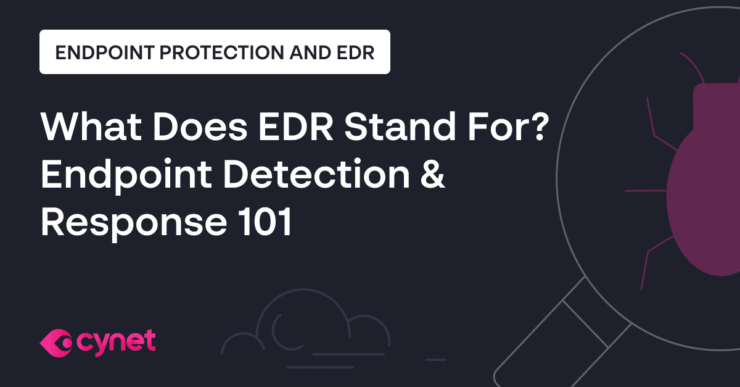Last Updated:
November 20, 2024
In recent years, research has shown that a majority of cyber attacks start by compromising an endpoint, not by breaching an organization’s security perimeter. Many organizations are deploying endpoint security platforms that defend against endpoint attacks using next-generation antivirus (NGAV), endpoint detection and response (EDR), User Behavioral Analytics (UBA) and more.
In the cloud, endpoint protection is even more important. Cloud architectures have a large number of endpoints and require a higher level of visibility. Endpoint protection tools can help organizations regain control over cloud workloads, and protect the weakest link of their security posture.
What Is Cloud Endpoint Security?
In an on-premises data center, endpoint security is used to protect devices like workstations, mobile phones and servers from cyber attacks. In the cloud, endpoints take a different shape—they may machine instances provided by services like Amazon EC2, storage volumes or buckets, or managed services like Amazon RDS.
It may appear that as you move to the cloud, there is less of a need for endpoint security. However, the opposite is the case. As workloads move to the cloud, the number of endpoints grows exponentially, endpoints change more frequently, and there is less central control and visibility. Each cloud endpoint is a potential entry point for attackers, and should be protected with a consistent layer of endpoint protection.
Cloud Endpoint Security Challenges
Private Cloud Endpoint Security
A private cloud is entirely within your organization’s control, and so it may appear that endpoints in a private cloud are inherently more secure. However, private cloud endpoints are still vulnerable to attack:
- Insider attacks—a malicious employee or compromised account can initiate a cyberattack from within your private cloud. Endpoints are typically connected to other endpoints and control systems via the network, and an attack can spread via lateral movement and privilege escalation to more sensitive resources. A common way to compromise endpoints is spear phishing, where attackers study the behavior of victims inside the organization and send a carefully-crafted, credible email and causes them to click a link and deploy their malicious code.
- Non-compliance liabilities—organizations need to make sure endpoint controls are properly configured and sensitive data is appropriately protected. If the required controls are not in place, and there is an audit or real breach, your organization may be at risk of losing their certification or being fined.
- Data leakage—occurs when intellectual property, an organization’s critical data, or safety controls are leaked to an outside source, very frequently via compromise of an unsecured endpoint. Data can be exfiltrated by malware installed on the machine by an attacker, tunnelled over existing communication protocols like DNS, and can also be transferred by a malicious user using cloud storage, FTP, Tor, or other methods.
Lastly, an organization needs to determine how its private cloud security interoperates with other corporate information and workloads away from the personal cloud. If any data is shared or exchanged, as in many hybrid cloud architectures, additional measures need to be implemented, such as integrating endpoint security management with security tools used for the cloud.
Learn more in our detailed guide to epp security.
Hybrid Cloud Endpoint Security
Hybrid cloud lets organizations manage a private cloud for critical data, while enjoying the scalability and affordability of the public cloud for large-volume storage, additional computing capacity, and dev/test environments. Endpoints deployed either on-premises or in the public cloud in a hybrid model are vulnerable to attack vectors affecting both public and private cloud environments.
Even more significantly, hybrid cloud endpoints are vulnerable to security concerns with the integration points between the on-premises data center and the public cloud. Security concerns include:
- Lateral movement from public to private cloud—an attacker gains access through the public cloud and performs lateral movement to access and infect private cloud resources. An infected endpoint may also automatically spread malware to other machines it is connected to, which may be on-premises.
- Compliance and security gaps—in many hybrid cloud environments, you do not have central visibility of all endpoints and cannot easily identify security gaps or missing security controls required by compliance standards.
- API vulnerabilities—APIs are also endpoints, which can expose sensitive information. Attackers can use an authentication/authorization token to obtain or manipulate sensitive information. Many hybrid cloud setups heavily rely on APIs, and it is a challenge to ensure all API endpoints are properly secured.
- Integration points—every integration point between clouds, or between systems from different vendors, can be vulnerable to attack.
Learn more in our detailed guide to advanced endpoint protection.
Public Cloud Endpoint Security
A public cloud is susceptible to attackers that may not be visible to IT and security staff and may not be under their control. Typically, the cloud provider is responsible for security measures of the cloud environment, and cloud users take responsibility for securing their workloads and configuring access in a secure way. Therefore, public cloud deployments are also vulnerable to private cloud and hybrid cloud security challenges outlined above.
Many organizations use multiple computing models, including public Infrastructure as a Service (IaaS) like Amazon EC2, Platform as a Service like Amazon Lambda and Software as a Service (SaaS) such as SalesForce or Microsoft Office 365. Identifying all the endpoints on each of these platforms, understanding the access controls made available by each cloud provider, and ensuring all endpoints are configured correctly, can be a challenge. Without specialized tools, you will not have central visibility and control over all public cloud endpoints, and may have to “hunt” for them and identify security configuration issues one by one.
- Map and continuously inventory cloud endpoints
Cloud environments are dynamic, with instances being spun up and down frequently. Establish continuous endpoint discovery and inventory processes to ensure every cloud instance, API, and workload is accounted for and monitored. Without this, unmanaged endpoints can be easily overlooked and exploited.
- Enforce unified security policies across hybrid environments
Hybrid cloud setups introduce complexity due to different security tools and controls across on-prem and cloud infrastructures. Use centralized management platforms that enforce consistent security policies across all environments, ensuring that endpoints in public, private, and hybrid clouds receive the same level of protection.
- Automate compliance checks and remediation
In cloud environments, compliance needs to be automated. Use tools that continuously scan endpoints for compliance violations and automatically remediate issues, such as misconfigured security groups or exposed storage buckets. This helps maintain compliance and reduce the risk of data leakage.
- Harden cloud workload configurations with least privilege principles
Apply the principle of least privilege not just to user roles but also to cloud workloads and services. Ensure that each cloud instance, container, or serverless function only has the permissions strictly necessary to perform its role. Regularly audit and remove unused permissions to minimize potential attack vectors.
- Integrate cloud endpoint protection with SIEM and SOAR platforms
To achieve unified threat detection and response, ensure your cloud endpoint protection integrates with your SIEM and SOAR systems. This provides broader visibility across hybrid and multi-cloud environments and enables automated incident response across all endpoints, whether cloud-based or on-prem.
Eyal Gruner is the Co-Founder and Board Director at Cynet. He served as the company’s CEO for nine years, guiding its growth from the very beginning. He is also Co-Founder and former CEO of BugSec, Israel’s leading cyber consultancy, and Versafe, acquired by F5 Networks. Gruner began his career at age 15 by hacking into his bank’s ATM to show the weakness of their security and has been recognized in Google’s security Hall of Fame.
Cloud Endpoint Protection with Cynet 360
Cynet 360 provides autonomous breach protection for cloud workloads, just like it does for on-premises machines. The Cynet 360 agent deploys seamlessly across machines in AWS, Azure and other cloud provides, proactively protecting from malware execution and monitoring for all process, network and user activities.
Cynet 360 empowers security managers to consolidate breach protection in one integrated interface, protecting on-prem, public cloud or hybrid infrastructure with one pane of glass.
Learn more about Cynet 360


![Top 6 EDR Tools Compared [2025 Update] image](https://www.cynet.com/wp-content/uploads/fly-images/46568/ENDPOINT-PROTECTION-and-EDR_1200x6277-740x424.png)
